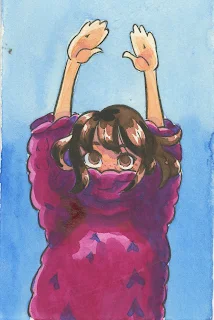Building Up Color and Contrast: Watercolor Basics
Recently we talked about layering, glazing, and blends as being the foundation for watercolor comic pages. Knowing how to execute and utilize these techniques, as well as having the patience to do so, is a huge part of being able to paint comic pages. Today I want to talk about some of those concepts in a bit more depth- using fills, glazes, and flat planes of color to develop color, contrast, and volume.
Fills, Glazes, and Flat Planes of Color
- Useful for defining forms on boxy shapes
- Useful for creating contrast and defining forms on architectural backgrounds
- Useful for building up volume
This builds on the cube form tutorial introduced in our Watercolor Basics post. Missed it? Check out that tutorial here. Plane by plane, layer by layer, we're able to build form by creating planes of shadow.
Adding Texture
There are other ways to build up form, value, and contrast. Using paint to create texture is a great way to achieve this goal, while rendering a more believable world.
In these cheap watercolor field tests, a knit texture is used to help create and define form.
In this Distress Marker Opaque White test, layers and saturations of white ink are used to build up a lace texture for an overdress.
In this Spectrum Aqua field test, several textures are utilized, from small half moons on the fish to create scales, to a splatter effect to give the impression of water spray.
And a soft, velvety moss texture is created by utilizing both blends and layers to create verdant transitions.
In this example, we're painting carpet, which is fairly simple and straightforward.
Something to keep in mind:
- Each layer should cover less than the last
- Let your brush do the work
- Utilize a variety of marks for visual interest
Other Types of Textures:
Painting Seagrass
Basic Textures-Brings and Stones
Painting Textures-Wood Grain
Painting Textures- Fur
Painting Textures- Glass
Painting Textures- Metal and Metallic
Developing Depth of Color
What do I mean by developing depth of color?
Layers:
Layers of color of varying saturations and intensities can help build up shape and form, as well as create visual interest. This can be achieved through a number of techniques including wet into wet blending (allowing your colors to mix, while wet, on the paper), wet over dry, negative painting, and glazes.
Creating Volume:
Layers of color can be used to create volume, either by developing form through layers of a single color (as demonstrated in my Lighting and Contrast mini series)
Distinguishing Shadow:
In the lighting and contrast mini series, we talked about using a single color to build up form. Shadows are of two varieties- cast shadows (something directly blocking the light) and shadows caused by a lack of light hitting the surface of the object. Lighting and Contrast discusses the second, but it's also important to understand and utilize the first as well.
Cast shadows can utilize a contrasting color to help neutralize the saturation of the initial color (such as a red violet over yellow), or can utilize a neutral color (generally a purplish indigo) for shadow.
Using contrasting and cool colors to push forms back:
Similar to using distinguishing shadow, using contrasting colors to push forms back creates a layer or transition to desaturated color, which feels further away to the viewer. Cool colors have a similar effect.
Delineating and defining form:
This can be done with traditional forms of inking (adding a black or colored ink to your art to create lineart), but it can also be done by 'inking' with your watercolors, adding final details with color pencils or watercolor pencils, or adding details with gouache.
Negative Painting Demonstration:
In this example, we're going to use grass, a subject that's always been difficult for me to execute, but is an important, reoccuring theme in 7" Kara.
Before we dive into the still images, here's a demonstration that shows how I think about rendering grass at a macro level. It demonstrates the rendering of grass by using
Fluid 100 Paper Field Test:
There are various ways you can build forms using watercolor, and there's no single solution to any problem. What's important is that you experiment with watercolor to find methods that work for the sort of stories you wish to tell.












Comments
Post a Comment